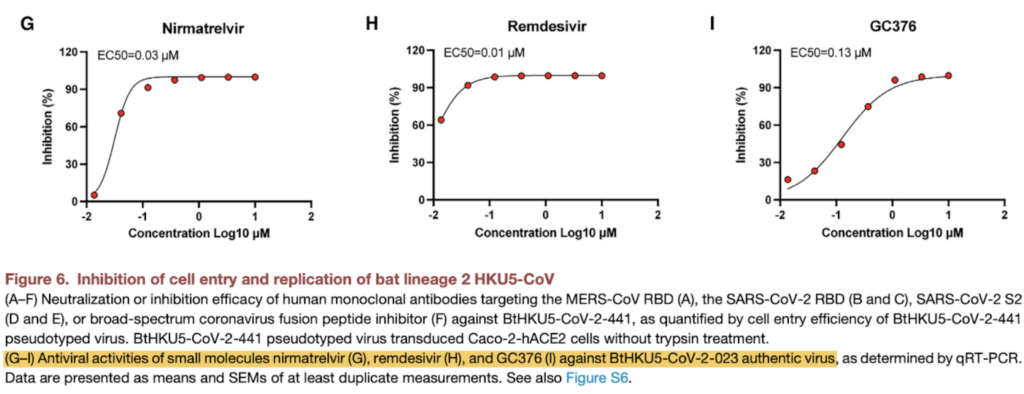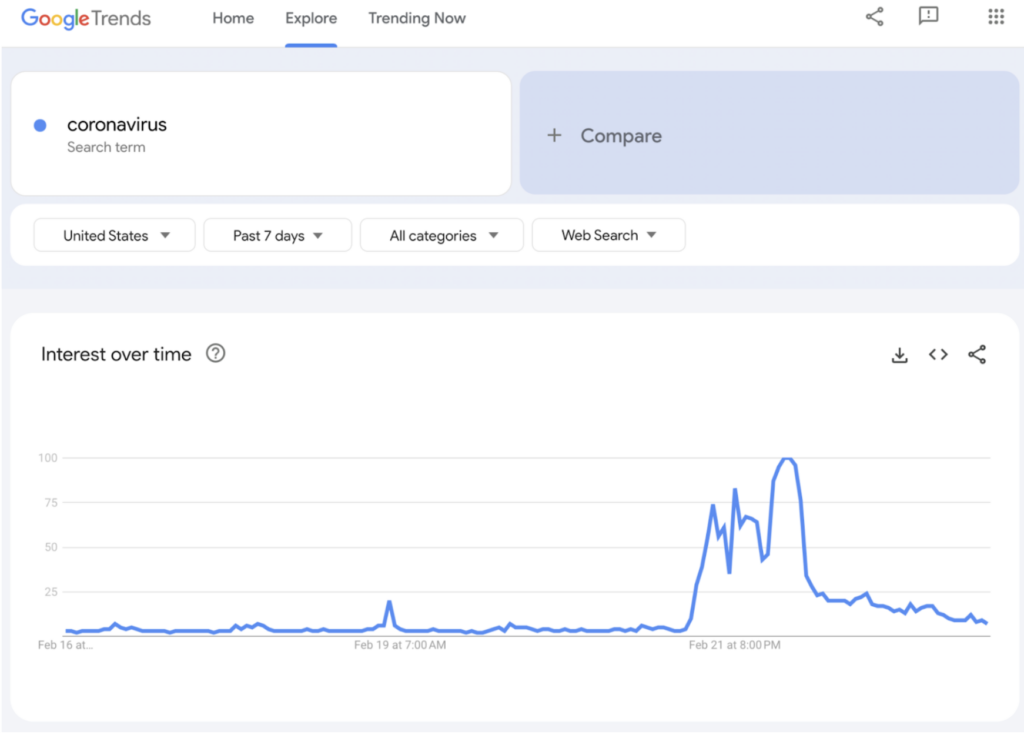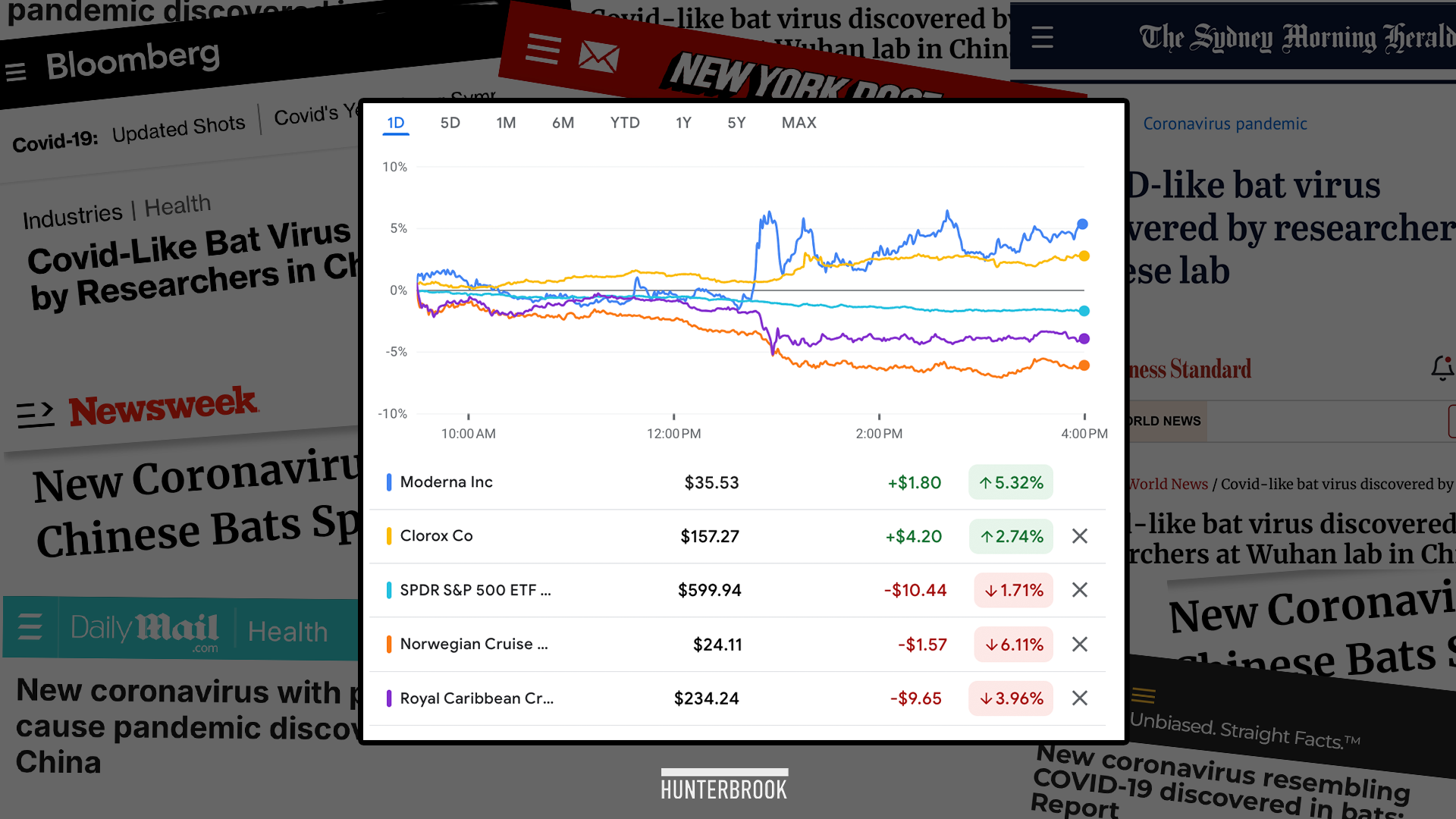Hunterbrook Media’s investment affiliate, Hunterbrook Capital holds both long and short positions across a broad range of securities that appear to be impacted by coronavirus news. Positions may change at any time. See full disclosures below.
No one is infected with the bat virus that became viral clickbait for hundreds of media outlets following a scientific paper published on February 18 in the research journal Cell. The author of this Hunterbrook Media article co-authored a molecular biology paper published in Cell. The research focused on treating heart disease and is not related to HKU5-COV-2.
There are no suspected cases of the virus infecting humans, according to statements by multiple experts. As a result, there are also no cases of human-to-human transmission. There may never be any cases. The experiments using HKU5-COV-2 are in artificially modified cells within a lab.
“We don’t know that this virus will produce any harm. All indicators are that it’s not going to do that,” said virologist and vaccine-maker Mario Barro, CEO of Givax, a biotechnology company developing vaccines to protect children from common viral infections. The author of this article previously worked as a venture partner at a healthcare investment firm that funded Givax. He does not have any financial interest in Givax or the investment firm.
“We have vaccines. We have antivirals. The virus is not close to a virus that actually transmits. And we don’t have any evidence it can actually infect a primate or a human. This virus is not going in the direction of a virus that could go to a scary situation,” he told Hunterbrook.
Before leading GIVAX, Dr. Barro — who holds a doctorate in virology and microbiology — worked as a postdoctoral fellow at Mount Sinai School of Medicine and the NIH; directed a universal flu vaccine project at the Biomedical Advanced Research and Development Authority (BARDA); and led research on flu vaccine strain selection at Sanofi Pasteur, the world’s largest vaccine developer.
“You have to infect an actual human. You need to be able to transmit human to human,” he said. “And it’s not the same situation like we had several years ago when we were not exposed to coronavirus like we are now.”
Barro criticized the sensationalist media coverage.
“The dangerous situation is to ring the alarm when you don’t need to because then no one will listen when it’s real,” he said. “I looked at what people have been publishing and it’s not well-balanced. We should not be ringing an alarm because of this paper.”
“We should be celebrating the fact that we are aware of these different viruses. We should be more cautious before we put out an alert from one paper,” he reiterated.
“My network is very worried about bird flu, but not about this virus.”
Unlike the early days of COVID-19 (SARS-COV-2) in December 2019 — when a handful of people were infected by a mysterious new virus — the research on HKU5-COV-2 did not take place in people, only in artificially modified human cells. The Cell study shows that the bat virus can infect these human cells using a similar process as COVID-19, building on related findings posted over six months ago on August 16, 2024, via the largest scientific preprint server bioRxiv.
The key experiments shown in the Cell article took place over several months leading up to the submission of the paper in September 2024. Since then, the research has been in peer review and months-long prepublication editing stages. So, the data introduced to the world last week was generated last year.
“This data didn’t just pop up in the last few days,” said Umer Raffat, a senior managing director at Evercore ISI focused on medicine and healthcare, during a Sunday morning webinar focused on countering what he called the “sensationalism” sweeping the media around the five year anniversary of the COVID19 outbreak. “Don’t worry about the timing of this paper.”
He highlighted that the experiment relied on adding a chemical called trypsin to the test tubes. Trypsin is a type of protein called an enzyme that helps break down other proteins. It is often used in experiments to optimize conditions for demonstrating certain results and for other lab purposes. In this case, it made it easier for the bat coronavirus to enter the modified human cells.
Importantly, COVID-19 does not require trypsin to enter human cells, unlike HKU5-CoV-2. “This is the problem with some of the press looking into some of these papers,” Raffat said. “The entire point of this paper is predicated on trypsin being added. When you put so much trypsin in, you’re creating these super conditions for cell entry to happen.”
The researchers in Cell concluded: “HKU5-CoV-2 has a better adaptation to human ACE2 than lineage 1 HKU5-CoV,” referring to the protein called ACE2 that is also used by COVID19 to infect human cells. “Authentic HKU5-CoV-2 infected human ACE2-expressing cell lines and human respiratory and enteric organoids. This study reveals a distinct lineage of HKU5-CoVs in bats that efficiently use human ACE2 and underscores their potential zoonotic risk.”
Raffat also scrutinized the potency of the virus. A key feature for infectivity known as binding affinity was 211-fold lower for HKU5-CoV-2 than the COVID19 strain Omicron, indicating that it may be much harder for HKU5-CoV-2 to enter human cells.
A colleague of Raffat’s also used the Google DeepMind machine learning algorithm AlphaFold to predict the three-dimensional structure of the part of HKU5-CoV-2 that binds ACE2. The prediction illustrated the biophysical explanation for the reduced binding affinity. Raffat noted that the Cell paper also includes data demonstrating that the FDA-approved antivirals Paxlovid (nirmatrelvir/ritonavir) and Veklury (remdesivir), which are widely used to treat COVID19, were also highly effective against HKU5-CoV-2 in the lab studies.

“We have antivirals on this already, so I don’t know what the worry is,” Raffat concluded, before turning to questions from the audience, where he added: “The existing arsenal is so active against it, it almost doesn’t matter.”
One audience member, rather than asking a question, pointed out that the key modified human embryonic kidney cell line (HEK-293T) used in the experiment wasn’t actually made up of T cells despite its acronym, highlighting the artificiality and preliminary nature of the experiments.
The new research took place at the Wuhan Institute of Virology, infamous for its proximity to the outbreak of COVID19, and as the prime suspect of the “lab leak” hypothesis that the pandemic began in a lab. This parallel helped catalyze hundreds of articles, leaving many people with the impression that there may be another Wuhan-linked pandemic.
HKU5-COV-2 could theoretically leap from bats to humans. Many diseases in humans begin with a species leap like this. But no leap has occurred. Even if a human were infected, human-to-human transmission would be required, and there would have to be sufficient virulence to cause spread.
The sensationalism appeared to begin with an article in the South China Morning Post that was then picked up on Friday by The Daily Mail, which headlined its piece: “New coronavirus with potential to cause pandemic discovered in China.”
There was a steep spike on Friday in Google search interest related to the term “coronavirus” — which had leveled off since the heights of COVID19. The trend appeared to have reverted by Sunday evening.

The Daily Mail headline also preceded notable moves in the stocks of companies linked to COVID-19.
Shares of Nasdaq-listed vaccine-makers like Moderna ($MRNA), Novavax ($NVAX), BioNTech ($BNTX), and CureVac ($CVAC) spiked, alongside an increase in Clorox (NYSE: $CLX). At the same time, shares of NYSE-listed cruise lines like Royal Caribbean Cruises ($RCL), Carnival Cruise Line ($CCL), and Norwegian Cruise Line ($NCLH) plummeted, alongside peers. So did shares of hotel, entertainment, and hospitality companies such as Wynn Resorts (NASDAQ: $WYNN), Hyatt Hotels (NYSE: $H), MGM Resorts International (NYSE: $MGM), and Airbnb (NASDAQ: $ABNB).
Rumors of a new pandemic were also cited by multiple outlets as one contributor to a general sell-off in the market on Friday, with the S&P 500 suffering its worst drop in over two months. The decline had begun earlier in the day, with news on inflation, consumer spending, and other macroeconomic factors.
There is no new human coronavirus — only a viral outbreak of misinformation.
An audience member asked Raffat, on a scale of 1 to 10, how concerned should we be about this news?
“Less than one is my take. Or one. On a scale of one to ten, one.”
Author
Nathaniel Horwitz is CEO of Hunterbrook. He has co-founded, invested in, and served on the boards of several biotechnology companies, ranging from AI-designed medicines for cancer to cell therapies for autoimmune diseases. He has a BA in Molecular Biology from Harvard, where he coauthored biomedical research in the scientific journal Cell — the same journal as the bat coronavirus research. His writing on medicine has been published in The Washington Post, The Atlantic, and The Daily Beast. His first job out of high school was reporting for his hometown newspaper, including an investigation of vaccination rates in local schools. He volunteers as executive chair of the 501(c)(3) education nonprofit Mayday Health.
Editor
Sam Koppelman is a New York Times best-selling author who has written books with former United States Attorney General Eric Holder and former United States Acting Solicitor General Neal Katyal. Sam has published in the New York Times, Washington Post, Boston Globe, Time Magazine, and other outlets — and occasionally volunteers on a fire speech for a good cause. He has a BA in Government from Harvard, where he was named a John Harvard Scholar and wrote op-eds like “Shut Down Harvard Football,” which he tells us were great for his social life. Sam is based in New York.
Hunterbrook Media publishes investigative and global reporting — with no ads or paywalls. When articles do not include Material Non-Public Information (MNPI), or “insider info,” they may be provided to our affiliate Hunterbrook Capital, an investment firm which may take financial positions based on our reporting. Subscribe here. Learn more here.
Please contact ideas@hntrbrk.com to share ideas, talent@hntrbrk.com for work opportunities, and press@hntrbrk.com for media inquiries.
LEGAL DISCLAIMER
© 2025 by Hunterbrook Media LLC. When using this website, you acknowledge and accept that such usage is solely at your own discretion and risk. Hunterbrook Media LLC, along with any associated entities, shall not be held responsible for any direct or indirect damages resulting from the use of information provided in any Hunterbrook publications. It is crucial for you to conduct your own research and seek advice from qualified financial, legal, and tax professionals before making any investment decisions based on information obtained from Hunterbrook Media LLC. The content provided by Hunterbrook Media LLC does not constitute an offer to sell, nor a solicitation of an offer to purchase any securities. Furthermore, no securities shall be offered or sold in any jurisdiction where such activities would be contrary to the local securities laws.
Hunterbrook Media LLC is not a registered investment advisor in the United States or any other jurisdiction. We strive to ensure the accuracy and reliability of the information provided, drawing on sources believed to be trustworthy. Nevertheless, this information is provided "as is" without any guarantee of accuracy, timeliness, completeness, or usefulness for any particular purpose. Hunterbrook Media LLC does not guarantee the results obtained from the use of this information. All information presented are opinions based on our analyses and are subject to change without notice, and there is no commitment from Hunterbrook Media LLC to revise or update any information or opinions contained in any report or publication contained on this website. The above content, including all information and opinions presented, is intended solely for educational and information purposes only. Hunterbrook Media LLC authorizes the redistribution of these materials, in whole or in part, provided that such redistribution is for non-commercial, informational purposes only. Redistribution must include this notice and must not alter the materials. Any commercial use, alteration, or other forms of misuse of these materials are strictly prohibited without the express written approval of Hunterbrook Media LLC. Unauthorized use, alteration, or misuse of these materials may result in legal action to enforce our rights, including but not limited to seeking injunctive relief, damages, and any other remedies available under the law.
